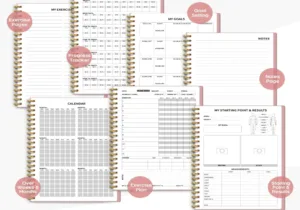Fitness journaling is a popular practice among fitness enthusiasts and wellness experts. It involves keeping a record of one’s fitness activities, meals, and overall health. The purpose of fitness journaling is to help individuals track their progress, set goals, and identify areas of improvement.
Keeping a fitness journal can be an effective tool for improving one’s health and fitness habits. By tracking their progress, individuals can identify patterns in their behavior and adjust their routine accordingly. Fitness journaling can help individuals stay motivated and accountable to their goals. Overall, fitness journaling is a simple yet powerful habit that can have a significant impact on one’s health and wellness journey.
Getting Started with Fitness Journaling
Starting a fitness journal is an excellent way to track progress, set achievable goals, and build a healthy habit. This section will cover the essential aspects of beginning a fitness journal, including choosing the right journal, setting achievable goals, and understanding the basics of tracking.
Choosing the Right Journal
Choosing the right journal is crucial when starting a fitness journal. It is essential to select a journal that is comfortable to use and fits the individual’s needs. There are many options available, including traditional notebooks, digital templates, and fitness-specific journals.
For beginners, a traditional notebook is an excellent choice. It is easy to use and allows for customization. For those who prefer digital options, there are many templates available online, which can be downloaded and printed. Fitness-specific journals are also available, which can provide structure and guidance for those who need it.
Setting Achievable Goals
Setting achievable goals is an essential step in fitness journaling. Goals should be specific, measurable, achievable, relevant, and time-bound. It is essential to set realistic goals that are challenging but not overwhelming.
For example, a goal to lose 10 pounds in a week is not achievable, and it can be discouraging if the goal is not met. A more achievable goal would be to lose 1-2 pounds per week.
Understanding the Basics of Tracking
Understanding the basics of tracking is another crucial aspect of fitness journaling. It is essential to track progress regularly and accurately. Tracking can include a variety of metrics, including weight, body measurements, and workout progress.
It is also essential to track non-physical progress, such as mood and energy levels. This can help individuals identify patterns and make adjustments to their routine.
Starting a fitness journal is an excellent way to track progress, set achievable goals, and build a healthy habit. Choosing the right journal, setting achievable goals, and understanding the basics of tracking are essential steps in beginning a fitness journal.
How to start a fitness journal

Starting a fitness journal can be a great way to track your progress, set goals, and stay motivated. Here’s a step-by-step guide to help you begin:
- Select Your journal: Choose a journal that you find appealing and that is practical for everyday use, whether it’s a dedicated fitness journal, a plain notebook, or a digital app.
- Define Your Goals: Clearly define what you want to achieve with your fitness routine, whether it’s weight loss, muscle gain, improved endurance, or another specific goal.
- Record Your Starting Point: Take note of your starting stats, such as weight, body measurements, and fitness level, to track your progress over time.
- Plan Your Workouts: Decide on your workout routine and schedule, and plan your workouts in advance.
- Track Your Nutrition: Keep a record of your daily food intake to understand the relationship between your diet and fitness performance.
- Monitor Your Progress: Regularly update your journal with the results of each workout, including exercises performed, weights lifted, sets, reps, and duration.
- Reflect on Your Feelings: After each workout, jot down how you felt physically and mentally. This can help you identify patterns and adjust as needed.
- Set Short-Term Milestones: Break down your long-term goals into smaller, achievable milestones to keep you motivated.
- Review and Adjust: Periodically look back on your entries to see what’s working and what’s not, and make adjustments to your fitness plan accordingly.
Fitness journal prompts
Here are 20 fitness journal prompts to get you started:
- Record your intentions for today’s workout.
- List the exercises you plan to do.
- Note the number of reps and sets for each exercise.
- Write down the weights you aim to lift.
- Track the duration of your cardio sessions.
- Observe how you feel before and after workouts.
- Identify any new personal bests you achieve.
- Reflect on the quality of your sleep last night.
- Assess your energy levels throughout the day.
- Log your water intake for the day.
- Describe the foods you eat and their portion sizes.
- Explore what motivates you to stay fit.
- Consider any obstacles that hinder your progress.
- Celebrate the successes you’ve had this week.
- Contemplate the areas you wish to improve.
- Think about how you can overcome challenges.
- Plan your recovery days and activities.
- Evaluate the balance of your workout routine.
- Summarize the progress you’ve made this month.
- Set new fitness goals for the upcoming week.
Recording Workouts and Progress
Keeping track of your workouts and progress is essential for achieving fitness goals. A fitness journal is a valuable tool to record workouts, track progress, and identify areas for improvement. In this section, we will discuss effective ways to log workouts and track progress.
Logging Workouts Effectively
When it comes to logging workouts, there are several methods to choose from, including paper journals, spreadsheets, and fitness tracking apps. Regardless of the method, it is important to record the following information accurately:
- Date and time of the workout
- Type of workout (strength training, cardio, etc.)
- Exercises performed
- Number of reps and sets
- Weight lifted
- Duration of the workout
Using a fitness tracking app can simplify the process of logging workouts. These apps allow users to record workouts, track progress, and set goals. Some popular fitness tracking apps include Fitbit, MyFitnessPal, and Strong.
Tracking Progress and Milestones
Tracking progress is a crucial part of achieving fitness goals. It helps individuals stay motivated and identify areas for improvement. Some common metrics to track include:
- Weight
- Body fat percentage
- Strength (measured by the amount of weight lifted)
- Cardiovascular endurance (measured by time or distance)
Setting milestones can also be helpful in tracking progress. Milestones can be short-term (weekly or monthly) or long-term (six months or a year). Examples of milestones include running a 5K, increasing the amount of weight lifted, or reducing body fat percentage.
Keeping a fitness journal is an effective way to log workouts, track progress, and achieve fitness goals. By accurately recording workouts and tracking progress, individuals can stay motivated and make progress towards their goals.
Fitness Journal for Nutrition and Diet Management

Fitness journaling is not just about tracking workouts. It is also about documenting meals and nutrition to help achieve fitness goals. Keeping track of what you eat and drink can help you identify areas where you need to improve and make necessary adjustments.
Documenting Meals and Nutrition
One of the most important aspects of nutrition management is documenting meals. This involves recording what you eat, how much you eat, and the nutritional value of the food. A food journal can help you keep track of your meals and monitor your calorie intake. It can also help you identify patterns in your eating habits and make changes to your diet accordingly.
In addition to tracking meals, it is also important to monitor your nutrient intake. This includes tracking your macro and micronutrients. Macros are the macronutrients that provide energy, such as carbohydrates, protein, and fat. Micronutrients are the vitamins and minerals that are essential for optimal health.
Hydration Tracking
Water intake is an essential component of a healthy diet. Hydration tracking can help you monitor your water intake and ensure that you are getting enough fluids throughout the day. Adequate hydration is important for maintaining energy levels, regulating body temperature, and flushing out toxins from the body.
One way to track hydration is by using a water bottle with measurements on it. This can help you keep track of how much water you are drinking throughout the day. Another way to monitor hydration is by tracking the color of your urine. Clear urine indicates that you are well-hydrated, while dark yellow urine indicates that you need to drink more water.
Documenting meals and tracking hydration are important aspects of nutrition and diet management. By keeping track of what you eat and drink, you can make adjustments to your diet and achieve your fitness goals.
Reflecting on Physical and Mental Wellness
Fitness journaling is a powerful tool that can help individuals monitor their physical and mental well-being. By reflecting on their body and mind changes, individuals can gain a deeper understanding of their feelings, energy level, and overall health.
Monitoring Body and Mind Changes
Keeping track of exercise routines, sleep patterns, and self-care practices in a fitness journal can help individuals monitor their physical and mental health. By recording the type and intensity of exercises, individuals can track their progress and identify areas for improvement. Tracking sleep patterns and energy levels can help individuals identify patterns and adjust their routines accordingly.
Moreover, journaling about feelings and emotions can help individuals identify stressors and triggers that affect their mental health. By writing down their thoughts and feelings, individuals can gain a better understanding of their emotional state and identify areas for improvement.
The Role of Sleep and Rest
Getting enough sleep and rest is crucial for maintaining physical and mental health. Fitness journaling can help individuals monitor their sleep patterns and identify areas for improvement. By tracking the quality and duration of sleep, individuals can identify patterns and adjust their routines accordingly.
Furthermore, incorporating meditation and other relaxation techniques into a fitness routine can also help individuals manage stress and improve mental health. By recording these practices in a fitness journal, individuals can track their progress and identify areas for improvement.
Fitness journaling is a powerful tool that can help individuals monitor their physical and mental well-being. By reflecting on their body and mind changes and incorporating self-care practices into their routines, individuals can improve their overall health and well-being.
Enhancing Motivation and Consistency
Keeping a fitness journal can be a powerful tool to enhance motivation and consistency in achieving fitness goals. Here are some tips to help with this.
Setting and Celebrating Small Wins
Setting small goals and celebrating when they are achieved can help build momentum and keep motivation high. For example, setting a goal of exercising for 30 minutes a day for a week can be a small win that can be celebrated. This can help to build a habit of consistency and motivate individuals to continue with their fitness journey.
Using Prompts and Quotes for Inspiration
Using prompts and quotes can be a great way to inspire and motivate individuals to stay consistent with their fitness journaling. For example, prompts such as “What are you grateful for today?” or “What did you learn from your workout today?” can help individuals reflect on their progress and stay motivated. Motivational quotes such as “The only bad workout is the one that didn’t happen” can also serve as a source of inspiration and motivation.
Frequently Asked Questions
What are the essential components to include in a fitness journal?
A fitness journal should contain the date, the type of exercise, the duration, and the intensity of the workout. It should also include the number of sets and repetitions for strength training exercises. Tracking progress by recording body measurements, weight, and heart rate can also be helpful.
How can a fitness journal assist in achieving weight loss goals?
A fitness journal can help individuals keep track of their calorie intake and the amount of physical activity they do each day. By analyzing the data, individuals can adjust their diet and workout routine to achieve their weight loss goals.
What are some creative ideas to personalize a fitness journal?
Some creative ideas to personalize a fitness journal include adding motivational quotes, using colorful pens, including pictures of fitness goals, and tracking progress with graphs.
What are the benefits of using a fitness journal app compared to a traditional journal?
Fitness journal apps offer the convenience of tracking workouts on a smartphone or tablet. They can also provide personalized recommendations based on the user’s fitness goals and progress. Fitness journal apps can sync with other fitness tracking devices, such as smartwatches and fitness bands.
How should one effectively structure the layout of a fitness journal?
The layout of a fitness journal should be easy to read and navigate. It is recommended to use a table or spreadsheet to organize the data. The journal should also include a section for notes and reflections.
Can maintaining a fitness journal contribute to improved workout results?
Yes, maintaining a fitness journal can contribute to improved workout results by providing individuals with a clear understanding of their progress and areas for improvement. It can also serve as a source of motivation and accountability.




